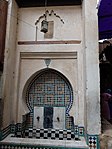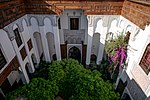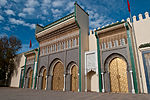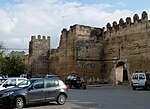Architecture of Fez
The architecture of Fez, Morocco, reflects the wider trends of Moroccan architecture dating from the city's foundation in the late 8th century and up to modern times. The old city (medina) of Fes, consisting of Fes el-Bali and Fes el-Jdid, is notable for being an exceptionally well-preserved medieval North African city and is classified as a UNESCO World Heritage Site.[1] A large number of historic monuments from different periods still exist in it today, including mosques, madrasas, synagogues, hammams (bathhouses), souqs (markets), funduqs (caravanserais), defensive walls, city gates, historic houses, and palaces.
History
Early history (9th-10th centuries)
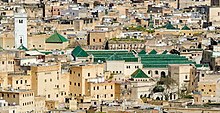
The city was founded on a bank of the
The earliest surviving Islamic-era monuments in Fez, the al-Qarawiyyin and Andalusi mosques, were built in the hypostyle form and made early use of the horseshoe or "Moorish" arch.[9][10] These reflected influences from major early monuments like the Great Mosque of Kairouan and the Great Mosque of Cordoba.[11] In the 10th century much of northern Morocco, including Fez, came directly within the sphere of influence of the Umayyad Caliphate of Cordoba, with competition from the Fatimid Caliphate further east.[8] Early contributions to Moroccan architecture from this period include expansions to the Qarawiyyin and Andalusi mosques and the addition of their square-shafted minarets, anticipating the later standard form of Moroccan minarets.[10][9]
Almoravid and Almohad era (11th-13th centuries)

The rise of the
The Almoravid-Almohad period is considered one of the most formative stages of Moroccan and Moorish architecture, establishing many of the forms and motifs that were refined in subsequent centuries.
Marinid period and golden age (13th-15th centuries)
Fez regained its political status and became recognised as the capital during the

The Marinids were also important in further refining the artistic legacy established by their predecessors. They built monuments with increasingly intricate and extensive decoration, particularly in wood and
The architectural style under the Marinids was also very closely related to that found in the Emirate of Granada, in Spain, under the contemporary Nasrid dynasty.[9] The decoration of the famous Alhambra is thus reminiscent of what was built in Fes at the same time. When Granada was conquered in 1492 by Catholic Spain and the last Muslim realm of al-Andalus came to an end, many of the remaining Spanish Muslims (and Jews) fled to Morocco and North Africa, resulting in another increase of Andalusian influence in Fez during subsequent generations.[22]
Decline and development under the Saadians and Alaouites (16th-19th centuries)

After the decline of the Marinid dynasty, Fes went into a mixed era of decline and occasional prosperity under the
The founder of the
From the reign of Moulay Muhammad ibn Abdallah onward Fez regained its power and prestige.[3] The Alaouites continued to rebuild or restore various monuments, as well as to expand the grounds of the Royal Palace a number of times. The final and most significant change to Fes's topography was made during the reign of Moulay Hasan I (1873-1894), who finally connected Fes el-Jdid and Fes el-Bali by building a walled corridor between them.[3][4] Within this new corridor, between the two cities, were built new gardens and summer palaces used by the royals and the capital's high society, such as the Jnan Sbil Gardens and the Dar Batha palace.[3][26] Moulay Hassan also expanded the old Royal Palace itself, extending its entrance up to the current location of the Old Mechouar while adding the New Mechouar, along with the Dar al-Makina, to the north. This had the consequence of also splitting the Moulay Abdallah neighbourhood to the northwest from the rest of Fes el-Jdid.[26]
French colonial period and present-day (20th-21st centuries)
In 1912 the
Under the Protectorate administration, French resident general Hubert Lyautey appointed Henri Prost to oversee the urban development of cities.[27][28] One important policy with long-term consequences was the decision to largely forego redevelopment of existing historic cities and to deliberately preserve them as sites of historic heritage, still known today as the "medinas". Instead, the French administration built new modern cities (the Villes Nouvelles or "New Cities") just outside the old cities, where European settlers largely resided with modern Western-style amenities.[29][30] New building regulations maintained the country's pre-existing architectural features and balanced it with the rapid urbanization. Nonetheless, while this policy preserved historic monuments, it had other consequences in the long-term by stalling urban development in these heritage areas and causing housing shortages in some areas.[29] It also suppressed local Moroccan architectural innovations, as for example in the medina of Fez where Moroccan residents where required to keep their houses – including any newly built houses – in conformity with what the French administration deemed to be the historic indigenous architecture.[30] In some cases French officials removed or remodeled more recent pre-colonial Moroccan structures which had been visibly influenced by European styles in order to erase what they deemed as foreign or non-indigenous interference in Moroccan architecture, such as the Bab Campini gate (now known as Bab Chems), which was built in an Italianate style in the 19th century but was rebuilt by the French in a "Moorish" style.[30]
In turn, French architects constructed buildings in the new cities that conformed to modern European functions and layouts but whose appearance was heavily blended with local Moroccan decorative motifs, resulting in a Mauresque[31] or Neo-Moorish-style architecture. In some cases, the French also inserted Moroccan-looking structures in the fabric of the old cities, such as the Bab Bou Jeloud gate in Fes (completed in 1913[4]) and the nearby Collège Moulay Idris (opened in 1918).[30]

In the Ville Nouvelle of Fez, both French and Moroccan proprietors constructed new buildings that followed contemporary European tastes but often included traditional Moroccan features.[32]: 172 Lyautey and the French authorities in Morocco were reticent to allow conspicuous orientalist constructions and pastiches of local Moroccan architecture. They discouraged what they saw as excessive néo-mauresque (Neo-Moorish) styles such as those seen in the architecture of French-controlled Algiers.[32]: 173–174 Nonetheless, some public buildings erected in the Ville Nouvelle by French authorities still made use of this style. Many apartment blocks built in the 1910s and 1920s also demonstrated this trend.[32]: 173–174 The first post office building, built in 1925 by architect Edmond Pauty, included local geometric motifs in its decorative details.[32]: 181 The state bank building (the present-day Bank al-Maghrib branch), built between 1928 and 1931 by architect René Canu, includes a frieze of sculpted plaster featuring an interpretation of arabesque motifs.[32]: 181 French authorities also encouraged builders to make use of local Moroccan labour and craftsmanship even if they weren't reproducing Moroccan motifs. For example, the main entrance of the building of the Court of First Instance (Tribunal de première instance), built in 1934, is decorated with zellij mosaic tilework of local Moroccan craftsmanship but depicting traditional French symbols of justice.[32]: 181

In the 1910s and 1920s many new constructions in the Ville Nouvelle were also built with Neoclassical influences. The façades of these buildings often had eclectic ornamentation in carved stucco. Their decorative motifs were of European origin, such as floral friezes, lion heads, seashells, cherubs, and other diverse elements.[32]: 183 The Ville Nouvelle of Fez developed more slowly than other major cities under French rule and a very large proportion its buildings from the pre-independence period (i.e. before 1956) were constructed between 1925 and 1935. After 1925 authorities became more reluctant to allow new buildings with ostentatious decoration in the downtown areas. As a result, the architecture became more somber and restrained from this period onward.[32]: 183–189 Some buildings were built in the Art Deco style.[32]: 172, 187 Private villas, which were built further away from the new city's main arteries and thus less visible, continued to be built in more ornate styles. Some villas from this period included salons with traditional Moroccan decoration.[32]: 187–192
Today, the Medina of Fez has conserved the original functions and architecture of its urban space, leading to its inscription on the World Heritage List in 1981.[1] The successful survival of traditional architecture can be attributed to the commitment to continue to reflect the styles of the successive waves of inhabitants, encroaching the city over its long history.[33]
Structure of the medina
The historic city of Fez consists of Fes el-Bali, the original city founded by the Idrisid dynasty on both shores of the Oued Fes (River of Fez) in the late 8th and early 9th centuries, and the smaller Fez el-Jdid, founded on higher ground to the west in the 13th century. It is distinct from Fez's now much larger Ville Nouvelle (new city) originally founded by the French. These two historic cities are linked together and are usually referred to together as the "medina" of Fez.[1]
The Medina of Fez constitutes an area of about 800 acres and is enclosed by 25 kilometres of
Architectural style
Fez contains many important examples of traditional
- Features of historic Moroccan architecture in Fez
-
Example of horseshoe arches, at the 14th-century Bou Inania Madrasa
-
Example of a muqarnas ceiling at the Bou Inania Madrasa
-
Example of geometric motifs in zellij tilework (below) and calligraphy in tile and carved stucco (above), at the Bou Inania Madrasa
-
Example of arabesque motifs in carved stucco at the 14th-century Al-Attarine Madrasa
-
Example of wooden surfaces with ornate carved motifs at the 14th-century Sahrij Madrasa
-
Example of a traditional minaret, at the Bou Inania Madrasa
Types of structures
Mosques
Major historic mosques
Mosques are one of the most prominent architectural structures in Fez. The purpose of a mosque is multifaceted, as it serves as a place for worship and prayer, but at the same time it was also traditionally used as a centre for education and learning. As such, mosques are an indispensable component of the urban fabric of the Medina, as they bring the community together and act as a social, community centre and educational centre.
There are numerous historic
A number of mosques date from the important
- Major historic mosques of Fez
-
Al-Qarawiyyin Mosque (founded in 9th century and expanded multiple times)
-
Entrance of theAl-Andalusiyyin Mosque(founded in 9th century and subsequently expanded)
-
The Zawiya of Moulay Idris II, originally the site of the Shurafa Mosque founded by Idris II (who is still buried here)
-
The Bou Jeloud Mosque (founded in the late 12th century)
-
Grand Mosque of Fes el-Jdid(founded in late 13th century)
-
Mosque of Abu al-Hasan(founded in 14th century)
-
Chrabliyine Mosque (founded in 14th century)
-
Al-Hamra Mosque (probably founded in 14th century)
-
Stone portal of the Lalla ez-Zhar Mosque (14th century)
-
Bab Guissa Mosque (founded in 14th century)
-
Moulay Abdallah Mosque (18th century)
-
Diwan Mosque (founded between 1792 and 1822)
-
El-Oued Mosque (founded between 1792 and 1822, replacing an earlier madrasa)
-
R'cif Mosque (founded between 1792 and 1822)
Other mosques
The old city still includes a multitude of other historic local mosques which are less well-documented. A 1932 study by Russian-French architect Boris Maslow described and illustrated some of them, but not all.[46][47] Some of them nonetheless have interesting architectural details and demonstrate variations from other classic Fassi mosques. The following are some examples for which information is available:
- The Mosque of Ain al-Kheil (also called the Al-Azhar Mosque), for example, has an octagonal minaret and has two prayer halls located on two levels; both features not found in typical mosques of the city.[20]: 132 [48] It is also reputed to have been frequented by the famous Sufi scholar Ibn Arabi and is therefore believed to have existed since the late 12th century (during the Almohad period).[48]
- The Al-Beida Mosque has a street fountain and a notable minaret that is prominently visible along the main street of Fes el-Jdid, just north of the Al-Hamra Mosque. Boris Maslow saw clear signs that it went through two different periods of construction, but no dates are indicated by scholars other than the assumption that it was built some time after the nearby Al-Hamra Mosque (14th century).[46]: 120 [3]: 101
- The Mzellja Mosque, located in the Douh neighbourhood (western Fes el-Bali), originally dates from the Marinid period and features an elegant decorative panel of square Kufic script above its street entrance.[46]
- The Derb esh-Sheikh (or Derb ech-Cheikh) Mosque, located just northeast of the Hammam al-Mokhfiya in the el-Gzira neighbourhood, has a minaret with a broad darj-wa-ktaf motif carved in brick on its southern and eastern facades (the sides facing the street) while its northern and western facades have been left blank. The secondary lantern-tower on top of the minaret's main shaft has been rebuilt in recent times.[46]: 110–111
- The Ras 'Ain Azliten Mosque, located in the 'Ain Azliten neighbourhood in northern Fes el-Bali, likely dates from the late 14th century during the Marinid period. Its minaret shares with the Derb esh-Sheikh minaret the characteristic of selective decoration: only its northern façade, facing the street, is finely decorated, while the other facades are blank.[46]: 107–108
- The minaret of the Zellja Mosque, visible next to the modern Boulevard Ben Mohammed El Alaoui (the main road leading to Place R'cif), is unusually simple and has no secondary lantern-tower at all, being instead capped by a small pyramidal roof of green tiles.[46]: 137–138
The Ville Nouvelle (New City) also includes many modern mosques from the 20th century or later. Some prominent landmark mosques here include the Imam Malik Mosque, the largest in the city and located near the train station,[49] and the Tunis Mosque (Masjid Tunis), dating from the French colonial period and located near the downtown area.[50]
- Other mosques of Fez
-
The octagonal minaret of the Ain al-Kheil Mosque, seen from the street below
-
The Al-Beida Mosque in Fes el-Jdid
-
Mzellja Mosque, with a decorative panel of square Kufic above its entrance (right)
-
Minaret of the Derb esh-Sheikh Mosque
-
The very simple minaret (right) of the Zellja Mosque, a local neighbourhood mosque
-
The Tunis Mosque in the Ville Nouvelle (New City), an example of a modern mosque in the city
Synagogues

The Mellah (Jewish quarter) of Fez Jdid is the site of the 17th-century Ibn Danan Synagogue, the Slat al-Fassiyin Synagogue, and multiple other synagogues, though none of them are functioning today.[4][51][52] Synagogues had a very different layout from mosques but often shared similar decorative trends as the rest of Moroccan architecture, such as colourful tilework and carved stucco.[4][53]
Madrasas
The madrasa was an institution which originated in northeastern Iran by the early 11th century and was progressively adopted further west.[9][20] These establishments provided higher education and served to train Islamic scholars, particularly in Islamic law and jurisprudence (fiqh). The madrasa in the Sunni world was generally antithetical to more "heterodox" religious doctrines, including the doctrine espoused by the Almohad dynasty. As such, it only came to flourish in Morocco in the late 13th century, under the Marinid dynasty which succeeded the Almohads.[9] To the Marinids, madrasas also played a part in bolstering the political legitimacy of their dynasty. They used this patronage to encourage the loyalty of the country's influential but independent religious elites and also to portray themselves to the general population as protectors and promoters of orthodox Sunni Islam.[9][54] Finally, madrasas also played an important role in training the scholars and elites who operated the state bureaucracy.[54] Fez has traditionally retained an influential position as a religious capital in the region, exemplified by the famous University of al-Qarawiyyin. Madrasas played a supporting role to this major institution, in part because, unlike the mosque, they provided accommodations for students who came from outside the city.[20]: 137 [35]
Madrasas were generally centered around a main courtyard with a central fountain, off which other rooms could be accessed. Student living quarters were typically distributed on an upper floor around the courtyard. Many madrasas also included a prayer hall with a mihrab. In the Marinid era, madrasas also evolved to be lavishly decorated.[20][9]: 110 However, the madrasas were also teaching institutions in their own right and offered their own courses, with some Islamic scholars making their reputation by teaching at certain madrasas.[35]: 141
The first formal madrasa was the
- Madrasas in Fez
-
Saffarin Madrasa (dated to 1271); the minaret (right) and prayer hall (left) are visible
-
Sahrij Madrasa (built in 1321–1328)
-
Al-Attarine Madrasa (built in 1323–1325)
-
Bou Inania Madrasa (built in 1350–1355)
-
Cherratine Madrasa (founded in 1670)
-
Mesbahiyya Madrasa (completed in 1346; photo from 1916)
Tombs, mausoleums, and zawiyas
Located in the heart of Fes el Bali, the
The old city also has several major historic cemeteries which existed outside the main city gates, namely the cemeteries of
- Tombs and zawiyas in Fez
-
Interior of the Zawiya of Sidi Ahmed al-Tijani, the burial site of the 18th-century Sufi sheikh Ahmad al-Tijani
-
Minaret of the Zawiya of Sidi Abdelkader al-Fassi (established in 17th century, expanded afterward)
-
Mausoleum of Sidi Harazem(current structure from 18th century; photo taken during recent restorations)
-
The cemetery of Bab Ftouh, the largest of the old city
-
The cemetery of Bab Mahrouk
-
Remains of the Marinid Tombs
Funduqs (historic merchant buildings)
The old city of Fez includes more than a hundred
- Funduqs in Fez
-
Funduq Shamma'in (founded in 13th century or earlier)
-
Funduq Staouniyyin(or Funduq al-Tetwaniyyin), founded in 14th century
-
Funduq al-Najjarin (built in 1711; currently the Nejjarine Museum of Wooden Arts & Crafts)
-
Entrance of the Funduq Sagha (also built in 1711)
-
Funduq Barka (18th century)[61]
-
Funduq Kettanin (late 19th century)
Hammams (bathhouses)

Fez is also notable for having preserved a great many of its historic hammams (public bathhouses in the Muslim world), thanks in part to their continued usage by locals up to the present day.[62][63][64] Out of the total 5000 hammãms in Morocco, 120 of them are located within Fez.[63] Notable examples, all dating from around the 14th century, include the Hammam as-Saffarin, the Hammam al-Mokhfiya, and the Hammam Ben Abbad.[65][62][63]
They were generally built next to a well or natural spring which provided water, while the sloping topography of the city allowed for easy drainage.[62] The layout of the traditional hammam in the region was inherited from the Roman bathhouse model. The first major room visitors entered was the undressing room (mashlah in Arabic or goulsa in the local Moroccan Arabic dialect), equivalent to the Roman apodyterium. From the undressing room visitors proceeded to the bathing/washing area which consisted of three rooms: the cold room (el-barrani in the local Arabic dialect; equivalent to the frigidarium), the middle room or warm room (el-wasti in Arabic; equivalent to the tepidarium), and the hot room (ad-dakhli in Arabic; equivalent to the caldarium).[62][63] Though their architecture can be very functional, some of them, like the Hammam as-Saffarin and the Hammam al-Mokhfiya, have notable decoration. Although they are architecturally not very prominent from the exterior, they are recognizable from the rooftops by their pierced domes and vaults which usually covered the main chambers.[62] Walls are coated with Tadlakt to smoothen their surfaces and to resist the high humidity.[34] The warm and hot rooms were heated using a traditional hypocaust system just as Roman bathhouses did, with furnaces usually located behind the hot room. Fuel was provided by wood but also by recycling the waste by-products of other industries in the city such as wood shavings from carpenters' workshops and olive pits from the nearby olive presses. This traditional system continued to be used even up to the 21st century.[62]
Street fountains (saqayyas)
Fes is also known for numerous fountains which offered free water. Fountains were often included in palaces for the pleasure of its residents, in mosques and madrasas for the purpose of ablutions, or even as part of specially-dedicated ablutions facilities attached to religious buildings. Many fountains, however, are also built along the sides of streets or on the exterior of buildings. According to historical authors, at the beginning of the 13th century there were around 80 fountains of this type in Fes.[3]: 57 These wall fountains of Fes generally share similar characteristics and decoration. Their original construction was often an act of charity sponsored by patrons with means, which is sometimes recorded by a surviving inscription. They are often decorated with zellij tiling, carved stucco, and a canopy of carved wood or even of muqarnas.[66]
Probably the most famous of these is the Nejjarine Fountain (Saqqayat an-Najjarin) located in front of the Funduq al-Najjarin (the present-day Nejjarine Museum). It was commissioned in the 19th century by the Sultan Abd al-Rahman (ruled 1822–1859).[67] It is richly decorated with a surface of zellij tiling framed by an arch of carved stucco, overshadowed by a canopy of carved wood surmounted by a short roof green tiles. Along its base, below the taps, is a rectangular basin.[67]
A much older example is the Fountain of Sidi Frej, located near the
- Traditional fountains in Fez
-
Fountain of Sidi Frej (built in 1426 with later restorations)
-
Nejjarine Fountain (19th century)
-
Another fountain on Tala'a Seghira (dated to 1923–24 according to its inscription)
Tanneries
Since the inception of the city, tanning industry has been continually operating in the same fashion as it did in the early centuries. Today, the tanning industry in the city is considered one of the main tourist attractions. There are three tanneries in the city, largest among them is Chouara Tannery near the Saffarin Madrasa along the river. The tanneries are packed with the round stone wells filled with dye or white liquids for softening the hides. The leather goods produced in the tanneries are exported around the world.[69][70][71] The two other major tanneries are the Sidi Moussa Tannery to the west of the Zawiya of Moulay Idris II and the Ain Azliten Tannery in the neighbourhood of the same name on the northern edge of Fes el-Bali.[3]: 220
- Tanneries in Fez
-
Ain Azliten Tannery
Historic houses and riads
Many old private residences have also survived to this day, in various states of conservation. One type of house known, centered around an internal courtyard, is known as a
Some of the houses include the Dar al-Alami,[75] the Dar Saada (now a restaurant), Dar 'Adiyil, Dar Belghazi, and others.[4] Larger and richer mansions, such as the Dar Mnebhi, Dar Moqri, and Palais Jamaï (Jamai Palace), have also been preserved.[4] Numerous palaces and riads are now utilized as hotels for the tourism industry. The Palais Jamai, for example, was converted into a luxury hotel in the early 20th century.[76][4] The lavish former mansion of the Glaoui clan, known as the Dar Glaoui, is partly open to visitors but still privately owned.[77]
- Historic houses and mansions in Fez
-
Dar Adiyel, an early 18th-century mansion
-
Dar Moqri, a late 19th and early 20th century palace
-
Dar Ba Mohammed Chergui (early 20th century)
-
Dar Mnebhi (early 20th century)
-
Courtyard of the Dar Glaoui
-
Example of a restored private riad in Fez
Royal Palaces
As a former capital, the city contains several royal palaces as well. A large area of Fes el-Jdid is taken up by the 80-hectare Royal Palace, or
- Royal palaces in Fez
-
Gates of theRoyal Palace of Fez(the gates were crafted in the 20th century but the palace has been established here since the late 13th century)
-
Dar Batha, a late 19th-century palace; now the Batha Museum
Gardens
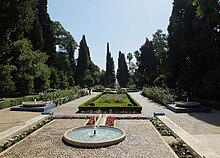
The Jnane Sbile Garden was created as a royal park and garden in the 19th century by Sultan Moulay Hassan I (ruled 1873–1894) between Fes el-Jdid and Fes el-Bali.[4]: 296 [3]: 100 Today it is the oldest garden of Fes.[79] Many bourgeois and aristocratic mansions were also accompanied by private gardens, especially in the southwestern part of Fes el-Bali, an area once known as al-'Uyun.[3] Other gardens also exist within the grounds of the historic royal palaces of the city, such as the Agdal and Lalla Mina Gardens in the Dar al-Makhzen or the gardens of the Dar el-Beida (originally attached to Dar Batha).[4][3][20] In the late 13th century the Marinid sultans created the vast royal garden of al-Mosara, which covered a vast area north of Fes el-Jdid, but these disappeared in the centuries after the fall of the Marinids.[18]
Fortifications
City walls
The entire medina of Fez was heavily fortified with crenelated walls with watchtowers and gates, a pattern of urban planning which can be seen in Salé and Chellah as well.[55] City walls were placed into the current positions during the 11th century, under the Almoravid rule. During this period, the two formerly divided cities known as Madinat Fas and al-'Aliya were united under a single enclosure. The Almoravid fortifications were later destroyed and then rebuilt by the Almohad dynasty in the 12th century, under Caliph Muhammad al-Nasir.[3] The oldest sections of the walls today thus date back to this time.[4] These fortifications were restored and maintained by the Marinid dynasty from the 12th to 16th centuries, along with the founding of the royal citadel-city of Fes el-Jdid.[80] Construction of the new city's gates and towers sometimes employed the labour of Christian prisoners of war.[55]
- City walls of Fez
-
View of unrestored city walls on the north side of the Fes el-Bali, likely dating from Almohad period (early 13th century)
-
Section of restored city walls near Bab Mahrouk
City gates
The gates of Fez, scattered along the circuit of walls, were guarded by the military detachments and shut at night.[55] Some of the main gates have existed, in different forms, since the earliest years of the city.[3] The oldest gates today, and historically the most important ones of the city, are Bab Mahrouk (in the west), Bab Guissa (in the northeast), and Bab Ftouh (in the southeast).[3][4] After the foundation of Fes Jdid by the Marinids in the 13th century, new walls and three new gates such as Bab Dekkakin, Bab Semmarine, and Bab al-Amer were established along its perimeter.[81][82] Later, in modern times, the gates became more ceremonial rather than defensive structures, as reflected by the 1913 construction of the decorative Bab Bou Jeloud gate at the western entrance of Fes el-Bali by the French colonial administration.[4]
- Gates of Fez
-
Bab Dekkakin (Bab es-Sebaa)
Forts and kasbahs
Along with the city walls and gates, several forts were constructed along the defensive perimeters of the medina during the different time periods. The city rapidly developed as the military garrison center of the region during the Almoravid era, in which the military operations were commanded and carried out to other North African regions and Southern Europe to the north, and Senegal river to the south. Subsequently, it led to the construction of numerous forts,
- Kasbahs and forts in Fez
-
Borj Sheikh Ahmed
Bridges

The Oued Bou Khrareb (part of the Oued Fes), which divides the northwestern and southeastern shores of Fes el-Bali, is crossed by several historic bridges, some of which were first built before the unification of the two shores into a single city in the 11th century.[86] There were once at least six bridges, reportedly built by the Zenata emir Dunas ibn Hamama in the early 11th century, before the unification of the two cities by the Almoravids later in the same century.[87][3][86] Other scholarly sources, however, attribute at least some of the bridges to the Almoravid period (late 11th to early 12th centuries) when the two early cities of Fes were unified.[12] Many of them were destroyed in subsequent floods in the early 14th century, and only some of them were rebuilt by the Marinid Sultan Abu Sa'id at the time.[87]
Of the bridges that remain today, the Qantrat Bin el-Moudoun ("Bridge Between the Two Cities") is the northernmost of them, followed to the south by the Qantrat Sebbaghin ("Bridge of the Tanners") and by the Qantrat Terrafin ("Bridge of the Cobblers") just north of Place R'cif. Another bridge, the Bridge of Sidi al-'Awwad, was located further south but likely disappeared during the 20th century when the river was covered by the modern paved road.[3] The Bin el-Moudoun Bridge, believed to date from the time of Emir Dunas ibn Hamama, was considered one of the most picturesque, being located amidst a stretch of rocky rapids.[35][87] It has a span composed of three arches but only the central one is still visible today.[12] The Sebbaghin Bridge, also known as the Khrashfiyin Bridge (or Khrachfiyine in the French transliteration), is believed to have been originally built by Emir Dunas and restored or rebuilt by the Marinids in the 14th century.[86][87] The Terrafin bridge, originally named Qantrat Bab al-Silsila and now found on the northern edge of Place R'cif, is also believed to date initially from Emir Dunas in the 11th century.[86][12][87] It is notable for having been lined with shops on both sides, a feature still partly visible in its structure today.[12][3]
Water supply system

The environment of Fez was gifted with plentiful water from an array of small rivers and streams that feed the Oued Fes and flow through the old city. Fes el-Bali was supplied by a complex and extensive system of canals and water channels which distributed water across both shores of the city. The historic water network, which survives today, was begun by Zenata emir Dunas ibn Hamama between 1037 and 1049 and then further elaborated by the Almoravid emir Yusuf ibn Tashfin between 1069 (the Almoravid conquest of Fes) and 1106.[88][12] Upstream from Fes el-Bali, the main river was also diverted and exploited for the creation of Fes el-Jdid during the Marinid period.[3]
A large number of waterwheels (known as norias, or sometimes saqiyyas) were located throughout the city's water network in order to assist in water distribution or to power certain industries.[3][88] Some of these were very large, such as the huge noria which supplied the Marinid royal gardens of Mosara, measuring 26 meters in diameter and 2 meters in thickness.[4] Only a few of these waterwheels have survived in some form, including some examples around the Jnan Sbil Gardens.[3][12]
List of notable historic monuments
Religious structures
Mosques:
- Al-Qarawiyyin Mosque
- Al-Andalusiyyin Mosque
- Zawiya of Moulay Idris II
- Al-Anouar Mosque (Mosque of the Sheikhs)
- Chrabliyine Mosque
- Bab Guissa Mosque
- R'cif Mosque
- Bou Jeloud Mosque
- Abu al-Hassan Mosque
- Mosque of the Kasbah an-Nouar
- Diwan Mosque
- el-Oued Mosque
- Ain al-Kheil Mosque
- Grand Mosque of Fes el-Jdid
- Moulay Abdallah Mosque
- Al-Hamra Mosque
- Al-Beida Mosque
- Lalla ez-Zhar Mosque
- Lalla Ghriba Mosque
Synagogues:
Madrasas:
- Saffarin Madrasa
- Sahrij Madrasa
- Sba'iyyin Madrasa
- Al-Attarine Madrasa
- Mesbahiyya Madrasa
- Bou Inania Madrasa
- Cherratine Madrasa
- Madrasa Fes el-Jdid (Madrasa Dar al-Makhzen)
- Madrasa el-Oued
- Madrasa Muhammadiyya (Madrasa Mohammadia)
Zawiyas and mausoleums:
- Zawiya of Moulay Idris II
- Zawiya of Sidi Ahmed al-Tijani
- Zawiya of Sidi Abdelkader al-Fassi
- Zawiya of Sidi Ahmed esh-Shawi
- Zawiya of Sidi Taoudi Ben Souda
- Zawiya of Sidi Ali Boughaleb
- Marabout of Sidi Harazem
- Marinid Tombs (ruined)
Civic and commercial structures
Funduqs (caravanserais):
- Funduq al-Najjariyyin
- Funduq Staouniyyin (Funduq al-Tetwaniyyin)
- Funduq Sagha
- Funduq al-Shamma'in & Funduq Sbitriyyin
- Funduq Barka
- Funduq Kettanin
Tanneries:
Hammams (bathhouses):
Fortifications
Walls:
Forts:
- Borj Nord
- Borj Sud
- Kasbah An-Nouar
- Kasbah Cherarda
- Kasbah Tamdert
- Dar Debibagh
- Borj Sheikh Ahmed, Borj Twil, and Borj Sidi Bou Nafa' (Saadian bastions in the eastern and southeastern wall of Fes Jdid)
City gates:
- Bab al-Amer
- Bab Bou Jeloud
- Bab Dekkakin (Bab es-Sebaa)
- Bab Ftouh
- Bab Guissa
- Bab Mahrouk
- Bab Semmarine
- Bab Segma
Palaces and historic houses
- Dar al-Makhzen (Royal Palace)
- Dar Batha
- Mnebhi Palace
- Dar Adiyel
- Dar Ba Mohammed Chergui
- Dar Belghazi
- Dar Glaoui
- Dar Moqri
- Jamai Palace
Other landmarks
- Dar al-Magana (Water clock)
- Maristan of Sidi Frej (historic hospital)
- Kissariat al-Kifah (bazaar)
- Borj Neffara (observation tower)
- Dar al-Makina (19th-century arms factory)
- Jnan Sbil Gardens
- Bridges of the Oued Bou Khrareb
References
- ^ a b c UNESCO World Heritage. "Medina of Fez". UNESCO World Heritage Centre. Retrieved May 15, 2019.
- ^ "Fes". Encyclopædia Britannica. 2007. Britannica Concise Encyclopedia. 3 Mar. 2007
- ^ a b c d e f g h i j k l m n o p q r s t u v w x y z aa ab ac ad ae af ag ah ai aj ak al am an ao ap aq ar as at au av aw ax Le Tourneau, Roger (1949). Fès avant le protectorat: étude économique et sociale d'une ville de l'occident musulman (in French). Casablanca: Société Marocaine de Librairie et d'Édition.
- ^ ISBN 978-2867701528.
- ^ a b c d Rivet, Daniel (2012). Histoire du Maroc: de Moulay Idrîs à Mohammed VI (in French). Fayard.
- ^ The Places Where Men Pray Together, p. 463, at Google Books p. 55
- ISBN 9781317870418.
- ^ ISBN 0521337674.
- ^ a b c d e f g h i j k l m n o p q r Marçais, Georges (1954). L'architecture musulmane d'Occident. Paris: Arts et métiers graphiques.
- ^ a b c Terrasse, Henri (1968). La Mosquée al-Qaraouiyin à Fès; avec une étude de Gaston Deverdun sur les inscriptions historiques de la mosquée. Paris: Librairie C. Klincksieck.
- ^ a b c Bennison, Amira K. (2016). The Almoravid and Almohad Empires. Edinburgh University Press.
- ^ S2CID 219625871.
- ^ a b Gaillard, Henri (1905). Une ville de l'Islam: Fès. Paris: J. André.
- ^ a b c d Salmon, Xavier (2018). Maroc Almoravide et Almohade: Architecture et décors au temps des conquérants, 1055-1269. Paris: LienArt.
- ^ Basset, Henri; Terrasse, Henri (1932). Sanctuaires et forteresses almohades. Paris: Larose.
- .
- ^ Deverdun, Gaston (1959). Marrakech: Des origines à 1912. Rabat: Éditions Techniques Nord-Africaines.
- ^ a b c Bressolette, Henri; Delarozière, Jean (1978). "El Mosara, jardin royal des Mérinides". Hespéris-Tamuda: 51–61.
- ^ "Qantara - Grand noria of Fez al-Jadīd". www.qantara-med.org. Retrieved 2020-04-03.
- ^ a b c d e f g h i j Parker, Richard (1981). A practical guide to Islamic Monuments in Morocco. Charlottesville, VA: The Baraka Press.
- ^ a b c Kubisch, Natascha (2011). "Maghreb - Architecture" in Hattstein, Markus and Delius, Peter (eds.) Islam: Art and Architecture. h.f.ullmann.
- ^ ISBN 978-3902782311.
- ISBN 9782359061826.
- ISBN 9782359061826.
- ISBN 2723301591.
- ^ ISBN 978-2343090221.
- .
- ^ Aouchar, Amina (2005). Fès, Meknès. Flammarion. pp. 192–194.
- ^ S2CID 145686603.
- ^ a b c d Holden, Stacy E. (2008). "The Legacy of French Colonialism: Preservation in Morocco's Fez Medina". APT Bulletin. 39 (4): 5–11.
- ^ The Rough Guide to Morocco (12th ed.). Rough Guides. 2019.
- ^ ISBN 9782847882391.
- ^ Radoine, Hassan. "Urban Conservation of Fez-Medina". Global Urban Development. Retrieved May 15, 2019.
- ^ a b c d Raftani, K; Radoine, H (2008). "The Architecture of the Hammâns of Fez, Morocco". International Journal of Architectural Research. 2 (3): 56–68.
- ^ ISBN 2723301591.
- ISBN 3822876348.
- ^ Jami' al-Qarawiyyin. Retrieved January 22, 2018.
- ^ Jami' al-Andalusiyyin. Retrieved January 22, 2018.
- ^ Terrasse, Henri (1964). "La mosquée almohade de Bou Jeloud à Fès". Al-Andalus. 29 (2): 355–363.
- ^ ISBN 2723301591.
- ^ Islamic Educational, Scientific and Cultural Organization (2017). "Fes: Capital of Islamic Culture for Arab Region". ISESCO. Archived from the original on May 15, 2019. Retrieved May 15, 2019.
- ISBN 978-0-313-32061-3, pp. 154–157
- ^ Belhachmi, Zakia: "Gender, Education, and Feminist Knowledge in al-Maghrib (North Africa) – 1950–70", Journal of Middle Eastern and North African Intellectual and Cultural Studies, Vol. 2–3, 2003, pp. 55–82 (65):
The Adjustments of Original Institutions of the Higher Learning: the Madrasah. Significantly, the institutional adjustments of the madrasahs affected both the structure and the content of these institutions. In terms of structure, the adjustments were twofold: the reorganization of the available original madaris and the creation of new institutions. This resulted in two different types of Islamic teaching institutions in al-Maghrib. The first type was derived from the fusion of old madaris with new universities. For example, Morocco transformed Al-Qarawiyin (859 A.D.) into a university under the supervision of the ministry of education in 1963.
- ^ Abu al-Hassan Mosque. Retrieved January 22, 2018.
- ^ Fez. Archnet. Retrieved January 23, 2018.
- ^ a b c d e f g h Maslow, Boris (1937). Les mosquées de Fès et du nord du Maroc. Paris: Éditions d'art et d'histoire.
- ^ "Boris Maslow (1893-1962). Les aventures d'un architecte russe au Maroc". Cité de l'architecture & du patrimoine (in French). Retrieved 2021-02-11.
- ^ a b "Al-Azhar Mosque". World Monuments Fund. Retrieved 2020-06-08.
- ^ "Mosquée Imam Malik". www.madein.city (in French). Retrieved 2021-02-12.
- ^ Roberson, Jennifer Anne (2004). The Mosque: Community and identity in late 20th-century Morocco and Spain (PhD thesis). University of Minnesota. p. 48.
- JSTOR 991758.
- ^ "Fez, Morocco Jewish History Tour". www.jewishvirtuallibrary.org. Retrieved 2020-04-08.
- JSTOR 991758.
- ^ ISBN 9782350314907.
- ^ a b c d Penell, C.R. Morocco: From Empire to Independence; Oneworld Publications, Oct 1, 2013. pp.66-67.
- ^ Shiratin Madrasa. Archnet. Retrieved January 23, 2018.
- ^ Sidi Ahmed al-Tijani Zawiya. Archnet. Retrieved January 22, 2018.
- ^ Funduq al-Najjariyyin. Archnet. Retrieved January 22, 2018.
- ^ "Fès: Les fondouks de la médina restaurés et labellisés". L'Economiste (in French). 2016-04-08. Retrieved 2020-04-07.
- ^ "Qantara - The al-Shammā'īn Funduq". www.qantara-med.org. Retrieved 2020-04-07.
- ^ "Funduq Barka". Archnet. Retrieved 2023-07-04.
- ^ a b c d e f Sibley, Magda (2006). "The Historic Hammāms of Damascus and Fez: Lessons of Sustainability and Future Developments". The 23rd Conference on Passive and Low Energy Architecture (Geneva, Switzerland, 6–8 September 2006).
- ^ a b c d Raftani, Kamal; Radoine, Hassan (2008). "The Architecture of the Hammams of Fez, Morocco". Archnet-IJAR. 2 (3): 56–68.
- ^ Secret, Edm. (1942). "Les hammams de Fes" (PDF). Bulletin de l'Institut d'Hygiène du Maroc. 2: 61–78. Archived from the original (PDF) on 2021-08-30. Retrieved 2021-01-09.
- ^ Terrasse, Henri (1950). "Trois Bains Mérinides du Maroc". Mélanges offerts à William Marçais par l'Institut d'études islamiques de l'Université de Paris. Paris: Éditions G.-P. Maisonneuve.
- ^ a b c d e Bel, Alfred (1917–1919). "Inscriptions arabes de Fès (III)". Journal Asiatique.
- ^ a b Nejjarin Funduq. Museum with no Frontiers. Retrieved January 23, 2018.
- ^ Madani, Tariq (2003). L'eau dans le monde musulman médiéval : L'exemple de Fès (Maroc) et de sa région. Université Lyon II (thesis).
- ^ Chouara Tannery. Archnet. Retrieved January 22, 2018.
- ^ Why You Need to Visit Fez in 20 Photos. Bloomberg. Retrieved January 22, 2018.
- ^ Aziza Chaouni: Hybrid Urban Sutures: Filling in the Gaps in the Medina of Fez." Archit 96 no. 1 (2007): 58-63.
- ^ Blaser, Werner. (2004). Courtyards in Marrakech. Basel, Switzerland: Publishers for Architecture.
- ISBN 2747523888.
- ^ Williams, Sarah. "A Brief History of Riads, Morocco's Exquisite Accommodation". Culture Trip. Retrieved May 30, 2019.
- ^ "Alami House". Archnet. Retrieved 2020-01-24.
- ^ "Histoire du Maroc : Palais Jamai, Patrimoine universel. – Cabinet Consulting Expertise International" (in French). Retrieved 2020-06-15.
- ^ "Palais Glaoui | Fez, Morocco Attractions". www.lonelyplanet.com. Retrieved 2020-01-24.
- ^ Mezzine, Mohamed. "Batha Palace". Discover Islamic Art, Museum With No Frontiers. Archived from the original on 2020-06-15. Retrieved February 12, 2021.
- ^ "Jnane Sbile or Bab Bou Jeloud garden in Fez". Morocco.FalkTime. 2018-07-09. Retrieved 2019-05-09.
- ^ Fortifications of Fès. Archnet. Retrieved January 22, 2018.
- ^ Meredith, Martin. (2014). Fortunes of Africa: A 5,000 Year History of Wealth, Greed and Endeavour. Simon and Schuster.
- ^ Hakluyt Society, (1896). Works Issued by the Hakluyt Society, p.592.
- ^ a b نفائس فاس العتيقة : بناء 13 قصبة لأغراض عسكرية. Assabah. Retrieved January 11, 2018.
- ^ Qasbah Dar Debibagh. 'Archnet Retrieved January 22, 2018.
- ^ البرج الشمالي. Museum with no Frontiers. Retrieved January 22, 2018.
- ^ a b c d "La magnifique rénovation des 27 monuments de Fès – Conseil Régional du Tourisme (CRT) de Fès" (in French). Archived from the original on 2020-04-22. Retrieved 2020-03-31.
- ^ a b c d e Gaillard, Henri (1905). Une ville de l'Islam: Fès. Paris: J. André. pp. 32.
- ^ a b Madani, Tariq (1999). "Le réseau hydraulique de la ville de Fès". Archéologie islamique. 8–9: 119–142.
Further reading
- Salmon, Xavier (2021). Fès mérinide: Une capitale pour les arts, 1276-1465. Lienart. (in French) – Extensive information and photography of Marinid-period architecture in Fez and other cities
External links
- Restauration 27 Monuments Historiques dans la Médina de Fès (captions in French) – YouTube video montage showing 27 historic monuments before and after recent restorations, including images of lesser-known buildings
- "Quelques ouvrages d'architecture d'importance sous le Protectorat à Fès" (text in French) – Photos and information for historic Protectorate-era buildings in the Ville Nouvelle











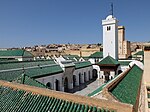


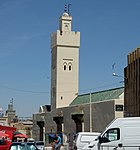



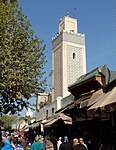

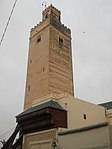

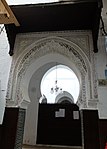
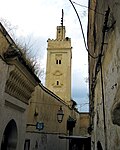




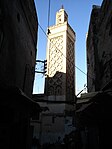

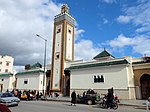
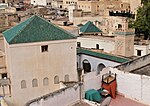









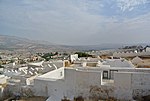


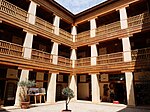


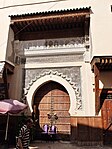
![Funduq Barka (18th century)[61]](http://upload.wikimedia.org/wikipedia/commons/thumb/b/b8/Funduq_Barka_DSCF3160.jpg/112px-Funduq_Barka_DSCF3160.jpg)

